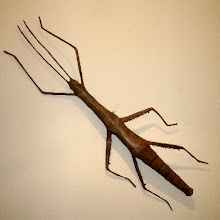It’s actually a pretty good guide, and several tips for technique and materials make it into the story. The artist isn’t too concerned about the membranes. I’ll keep peeling them, thank you.
She recommends a specific dye – Tintex clothing dye, soaking the shells for 20 minutes. Tintex dye is still made though not easy to find. It can be mail ordered for about a dollar a box. I’ll be testing it along with other dyes once I have them all gathered together. There is another, completely different Tintex dye made in Australia, which will probably be the first thing you find if you search for Tintex on the internet.
Click on the image to see it full size.
By KAY SHERWOOD
(Newspaper Enterprise Association)
If your artistic sense is feeling dull and undernourished, how about a pop art pick-me-up, a far-out something you can concoct yourself right at the old kitchen table?
A "marvy" young career girl I know telephoned me the other day from her steamy intellectual den in the heart of Manhattan to ask me how my family liked eggs.
Her domestic concern for our family's cuisine was out of character (I think she lives on black coffee and bright ideas) and the urgency of a long-distance telephone inquiry made me suspect my enthusiastic young friend was going to involve me in a "project." The last time we talked she persuaded me to try my hand at batik design—an encounter that left with me a deeper regard for the East Indians who know what they are up to in batik. I was right.
Pop Art
“Save the shells, it's the shells you'll need."
"How many?"
"Oh, about five dozen — I've had everyone in the office saving eggshells and bringing them to me. Just wait till you see."
"See what?" I asked, intrigued.
"Eggshell mosaics, absolutely wild, marvy. It's pop art for real," came the breathless answer.
A basic concept of pop art, I gather, is taking the ordinary object and turning it into something extraordinary. I allowed eggshell mosaics would certainly fill the bill.
First Step
"O.K.," I told her. "Send me pictures of what you're doing and I'll start saving eggshells." I'm not up to the five dozen yet but I have followed her directions for a small preliminary mosaic to see how it goes.
Shells are rinsed and saved. Eventually they are dyed with home fabric dyes. Why are fabric dyes recommended? I asked the Tintex Color Council who underwrote t h e experiments. The answer is that home fabric dyes come in a wide range of colors, including some subtle shades, that they won't fade, are inexpensive and will dissolve readily in hot water from the tap.
First step is to sketch or trace a design on heavy cardboard. You might like the sunburst effect shown with this story or a still life, landscape or a bizarre subject flavored by pop artists: soup can labels, soap boxes, comic strip characters.
Dye Shells
Dye shells, using separate bowls for each color. Leave the shell fragments in the dye for 20 minutes. Work with at least two colors to achieve variety of shading. Don't worry about the membrane inside the shell. It takes on a different shade in the dye bath.
When the shells are dry, break them into small pieces and glue them into position on your design, using a clear or white adhesive. Cover a small area at a time. Set the shell fragment on the glue and anchor it with a firm poke from an instrument, such as a letter opener.
The shell bits won't conform exactly to your sketch but the end result is the mosaic effect. When all bits are glued in place, spray with clear varnish or plastic sealer.
The photo caption reads...
AN ARTISTIC END to the morning's scrambled eggs is the eggshell mosaic in a sunburst design shown here. Design is drawn on a white palette board. Shells were tinted red for the background, black for the outlines and filled in with dyed shades of blue. White adhesive is squeezed on a small area at a time. Shell fragments are poked into place with a letter-opener. Finished mosaic is protected by a spray coating of clear varnish. Dyes used on the shells are the nonfading home fabric dyes with a T-7 catalyst.





No comments:
Post a Comment